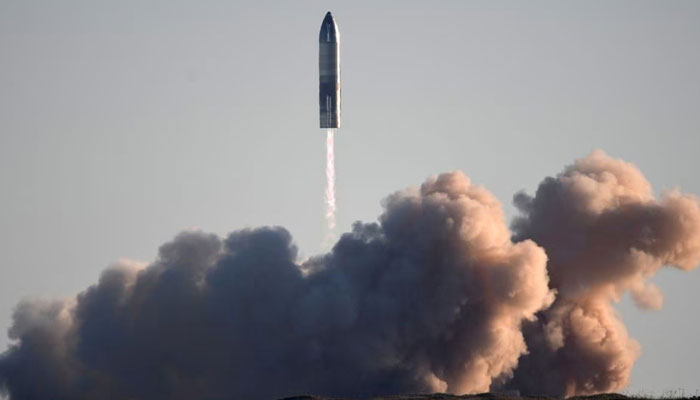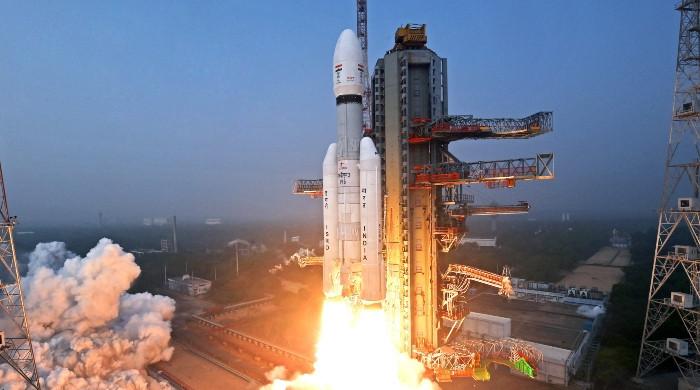Elon Musk’s Starship is set for test flight on Monday
Despite Starship's exceptionalism, Elon Musk's SpaceX acknowledged that the first flight could be risky
April 16, 2023

Tech billionaire Elon Musk's SpaceX is all prepared to lift off its giant stainless rocket Starship for a test flight — possibly on Monday — which aims to carry humans to the space exploration mission after its success.
Paulo Lozano, director of MIT's space propulsion laboratory said while quoted in NPR: "It's a very complex machine; it has so many different components." It is the largest space rocket built to date and it will be successful if all the engines perform well.
On Friday, US Federal Aviation Administration (FAA) granted SpaceX permission for a test flight by saying: "After a comprehensive licence evaluation process, the FAA determined SpaceX met all safety, environmental, policy, payload, airspace integration and financial responsibility requirements."
Musk said while standing before Starship a year ago: "Eventually the Sun will expand and destroy all life. It is very important – essential in the long-term – that we become a multi-planet species."
According to Musk who is also the CEO of Twitter and Tesla, the Starship will work as a multi-planetary vehicle, which would allow the astronauts and space agencies to carry their payloads at a cheap cost. He also believes that his ship will be carrying people to Mars.
Other than space exploration, the company has other business interests such as Starship could launch a large number of the company's internet-providing “Starlink” satellites — a pivotal component of SpaceX’s future.
Tim Farrar, the president of TMF Associates, a telecom consulting firm was of the view that Starship would allow the network to rapidly grow.
Despite its exceptionalism, SpaceX acknowledged that the first flight could be risky.
Starships are built to fly
The 400-foot-tall starship is made of stainless steel as weight matters a lot in spaceships.
Musk told the Space Studies Board of the National Academics in 2021 that SpaceX started out looking at advanced, lightweight composites for Starship but he found out that steel was cheap, abundant, and most importantly, incredibly tough.
"It could hold cryogenic rocket fuel and tolerate the gruelling heat of re-entry better than other materials," Musk said.
While joking, CEO SpaceX noted "I'm a big fan of stainless steel. Stainless steel and I should get a room or something."
Unlike other space rockets, SpaceX opted for an unconventional fuel choice – methane. Lozano maintained that most high-powered rockets use hydrogen for fuel because it is lightweight and highly efficient.
The choice behind methane could be: It is easier to handle than hydrogen and cheaper to produce, and it is available on Mars. This implies the ship would be refuelling itself from getting methane from the red planet's atmosphere.
"I think the idea, down the road, is to use methane that is found on places like Mars," Lozano said.
The starship is supported by all-powerful six engines called Raptors. For lifting purposes, 33 engines would be used simultaneously.
Lozano added: Again, the decision to use such a large number of engines is a trade-off. It allows the rocket to produce an enormous amount of thrust, which it needs to get off the ground.
He also underlined that "Having that large number of rocket engines firing simultaneously – it's actually quite hard. I think that's going to be one of the biggest challenges."
It is not the first time that a space rocket is using this number of engines. Back in the 1960s Soviet Union built a large rocket for the moon mission named N1 using 30n engines.
But the difficulty is that were any of these engines to explode, it would cost the whole rocket.
Soviets' four prototypes exploded due to this after which they abandoned the mission. On the contrary, in American Saturn V rocket, used five enormous engines which allowed the astronauts to land on the moon.
SpaceX's ship won't be carrying an interplanetary mission but will use it to transport its satellites into orbit for its internet service Starlink — a major source of revenue for the company.
"In order to continue to grow their subscriber base, they need more capacity and that's going to require more and bigger satellites," Tim Farrar said.
Starships can launch a number of satellites far larger and heavier.
"If they can get Starship going that will clearly help a lot," Farrar noted.
Nasa has also rewarded contracts worth billions of dollars for its Artemis moon mission.
Farrar stated: The launch of Starship comes at a difficult time for the tech industry.
He also noted: For now, investors seem happy to let SpaceX try out its massive potentially interplanetary rocket. But if the launch fails and Starship falls further behind schedule, it could affect all of SpaceX's business, especially in the current financial climate.









